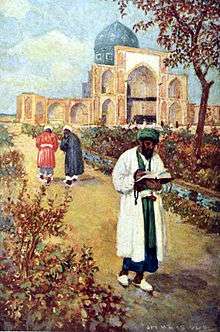Jay Hambidge

Jay Hambidge (1867–1924) was a Canadian-born American artist who formulated the theory of "dynamic symmetry", a system defining compositional rules, which was adopted by several notable American and Canadian artists in the early 20th century.
Early life and theory
He was a pupil at the Art Students' League in New York and of William Chase, and a thorough student of classical art. He conceived the idea that the study of arithmetic with the aid of geometrical designs was the foundation of the proportion and symmetry in Greek architecture, sculpture and ceramics.[1] Careful examination and measurements of classical buildings in Greece, among them the Parthenon, the temple of Apollo at Bassæ, of Zeus at Olympia and Athenæ at Ægina, prompted him to formulate the theory of "dynamic symmetry" as demonstrated in his works Dynamic Symmetry: The Greek Vase (1920)[2] and The Elements of Dynamic Symmetry (1926).[3] It created a great deal of discussion.[1] He found a disciple in Dr. Lacey D. Caskey, the author of Geometry of Greek Vases (1922).[4]
In 1921, articles critical of Hambidge's theories were published by Edwin M. Blake in Art Bulletin, and by Rhys Carpenter in American Journal of Archaeology. Art historian Michael Quick says Blake and Carpenter "used different methods to expose the basic fallacy of Hambidge's use of his system on Greek art—that in its more complicated constructions, the system could describe any shape at all."[5] In 1979 Lee Malone said Hambidge's theories were discredited, but that they had appealed to many American artists in the early 20th century because "he was teaching precisely the things that certain artists wanted to hear, especially those who had blazed so brief a trail in observing the American scene and now found themselves displaced by the force of contemporary European trends."[4]
Dynamic symmetry
Dynamic symmetry is a proportioning system and natural design methodology described in Hambidge's books. The system uses dynamic rectangles, including root rectangles based on ratios such as √2, √3, √5, the golden ratio (φ = 1.618...), its square root (√φ = 1.272...), and its square (φ2 = 2.618....), and the silver ratio ( ).[6][7]
From the study of phyllotaxis and the related Fibonacci sequence (1, 1, 2, 3, 5, 8, 13, 21, 34, 55, 89, 144, ...), Hambidge says that "a much closer representation would be obtained by a substitute series such as 118, 191, 309, 500, 809, 1309, 2118, 3427, 5545, 8972, 14517, etc. One term of this series divided into the other equals 1.6180, which is the ratio needed to explain the plant design system."[8] This substitute sequence is a generalization of the Fibonacci sequence that chooses 118 and 191 as the beginning numbers to generate the rest. In fact, the standard Fibonacci sequence provides the best possible rational approximations to the golden ratio for numbers of a given size.
A number of notable American and Canadian artists have used dynamic symmetry in their painting, including George Bellows (1882–1925),[9] Maxfield Parrish (1870–1966),[10] The New Yorker cartoonist Helen Hokinson (1893–1949), Al Nestler (1900–1971),[11][12] Kathleen Munn (1887–1974),[13] the children's book illustrator and author Robert McCloskey (1914–2003),[14] and Clay Wagstaff (b. 1964).[15]
See also
References
- 1 2 Blake, Edwin M. (1921) "Dynamic Symmetry-A Criticism". The Art Bulletin. 3 (3): 107–127.
- ↑ Dynamic Symmetry: The Greek Vase
- ↑ The Elements of Dynamic Symmetry
- 1 2 Bellows, George (1979). George Wesley Bellows: Paintings, Drawings, and Prints. Columbus, Ohio: Columbus Museum of Art. p. 3. OCLC 228660551.
- ↑ Bellows, George, and Michael Quick (1992). The Paintings of George Bellows. Fort Worth, Tex: Amon Carter Museum. p. 94 n. 55. ISBN 0883600684.
- ↑ Hambidge, Jay (2003) [1920]. Dynamic Symmetry: The Greek Vase (Reprint of original Yale University Press ed.). Whitefish, MT: Kessinger Publishing. pp. 19–29. ISBN 0-7661-7679-7.
- ↑ Matila Ghyka (1977). The Geometry of Art and Life. Courier Dover Publications. pp. 126–127.
- ↑ Hambidge (1920) p. 159; note that his cited ratio 1.6180 is exact only for the pair 500, 809.
- ↑ Bellows, George (1979). George Wesley Bellows: Paintings, Drawings, and Prints. Columbus, Ohio: Columbus Museum of Art. pp. 3–4. OCLC 228660551.
- ↑ Ludwig, Coy L., Diane Casella Hines, Robert Fillie, James Craig (1973). Maxfield Parrish. New York, NY: Watson-Guptill Publications. p. 142. ISBN 0823038971.
- ↑ Nestler, Al (1966). Moods in Oils and Felt Pens. [Tustin, Calif.]: [Foster art Service]. ASIN B000BJTB32
- ↑ Nestler, Al (1970). Color and Composition. Tustin, CA.: Walter T. Foster. ASIN B000BJOB8W
- ↑ eBook by Georgiana Uhlyarik, Canada Art Institute
- ↑ McCloskey, Jane (2016). McCloskey: Art and Illustrations of Robert McCloskey, Downeast Books.
- ↑ New American Paintings No. 48, p. 153. The Open Studios Press, Boston, 2003.
External links
- Works by Jay Hambidge at Project Gutenberg
- Works by or about Jay Hambidge at Internet Archive
- Elements of Dynamic Symmetry at Archive.org
- The Greek Vase at Archive.org
- Hambidge Center for Creative Arts and Sciences

